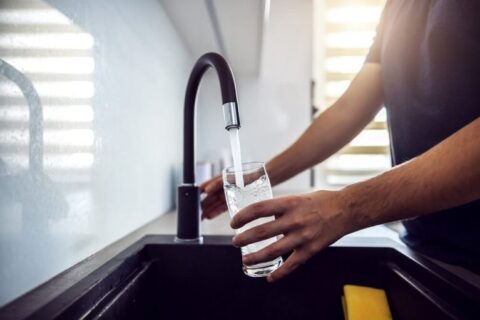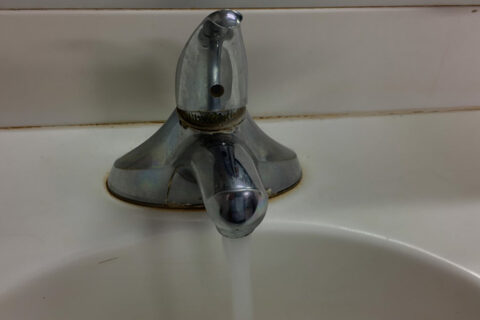Why is my tap water cloudy?
Have you ever run water from your faucet into your drinking glass, only to discover that you have milky looking water? You might wonder, “why is my tap water cloudy” and ponder whether it’s safe to drink. It might comfort you to know that cloudy tap water is fairly common; millions of people in the United States have experienced the problem of milky water coming from their taps. Most of the time, this water is safe to drink, but it’s important to determine what’s making your tap water cloudy before you decide whether or not to drink it. Once you’ve determined the cause, you can decide whether or not to drink the water, and perhaps call in someone who can help you figure out how to fix cloudy tap water.
- Typically, tap water becomes cloudy because of air bubbles trapped in the plumbing. A change in pressure can make this happen, and that can be the result of repair work, either at your home or nearby. If you have had plumbing work done in your home recently, you can probably safely assume that’s the cause of the problem, but just to be sure, test the water to make sure it’s really just air bubbles. You can do this by putting water in a clear glass and letting it sit still for a while. If the cloudiness begins to clear, starting at the bottom of the glass and working its way up, you can be confident that your problem is just trapped air. To release the air in your pipes, all you need to do is turn on the cold-water faucet nearest to your interior shutoff valve. With that tap running, open and close the valve several times, and this should release the air and clear your water. If you have not had plumbing work done, and you are not sure what could be causing the issue, ask your neighbors if anyone else is having the problem of cloudy water from the tap. If no one else is having this problem, that means it is confined to your house and you should call a plumber. Unexplained water pressure fluctuations could be the result of a burst or leaking pipe, which can lead to more extensive problems with your plumbing and expensive water bills.
- If you’ve ruled out air bubbles, your cloudy water could be caused by a problem with a faucet or the water heater. To determine if that’s the case, run water from several different faucets in your home. If only one faucet is producing cloudy water, take off the aerator, clean it with a half-vinegar, half-water solution, then rinse and reinstall it. If that doesn’t work, and that faucet is still delivering milky water, call a plumber to determine how to get rid of cloudy water from that faucet. If the problem is not just with one faucet, but with all of your faucets, check to see if it’s only the hot water is cloudy. Sometimes this is just a normal thing with hot water because gases trapped by water molecules expanding in the heat can cause water to look cloudy. If the cloudy look persists, though, it’s a more serious problem and probably means your water heater needs repair. Call a plumber in as soon as you can because water heater issues can be dangerous.
- If you live in a hard water area, your water may be cloudy because of limescale in your pipes. Hard water has a high mineral content, and these minerals can create chalky white deposits in your faucets and pipework. Though it is not necessarily hazardous to human health, hard water can make your glasses and silverware spotty, leave a filmy feeling on your hands after you wash them, and make your hair and skin feel dry. It can cause your clothes to develop stains and wear out quickly, leave film and scale deposits on your fixtures, and disrupt your water pressure by building up in the pipes. If hard water is your problem, the cloudiness in your water will not go away on its own. You can fix the problem, though, by having a water softener system installed.
- In some cases, cloudy tap water can be the result of contaminants, pollutants, or sediment in the water. While hard water and air bubbles are generally not dangerous to your health, there are certain contaminants that, when present in the water supply, can be hazardous. Sometimes, for example, cloudy water indicates the presence of methane gas, which can cause dizziness, blackouts, rashes, high blood pressure, and leg swelling. It can also mean that there’s rust or sludge building up in your pipes. If your cloudy water has a color, like brown, green, or yellow, do not risk drinking it. Instead, have your water analyzed so that you can determine what is causing the problem, and find the right water filtration system to address your issue, clear the contaminants from your water, and make it safe to drink.
If your water has a strange taste or appearance, your first step in finding the problem and fixing it is to have the water analyzed so that you can determine what to do. For a free water analysis and consultation, trust Kinetico Quality Water to test your water and help develop a treatment plan. Kinetico is Phoenix, Arizona’s local source for water treatment, providing the cleanest, greenest, most efficient drinking water filtration and water softener systems ever made. We understand the challenges in the Valley of the Sun, and our systems use less water than traditional water softeners. What’s more, we stand behind our products with the most comprehensive warranty coverage in the industry. Call or contact us for a free quote.


